Welcome to an intriguing journey into the heart of Middle Eastern culture and tradition. Today, we delve into the captivating world of Arabic coffee – a beverage that is much more than just a caffeinated drink. Arabic coffee, brewed meticulously in an iconic Arabic coffee pot, is a symbol of hospitality, a ritual at social gatherings, and a testament to the region’s rich history.
Arabic coffee, or ‘Gahwa’ as it’s known in the Arab world, is steeped in time-honored practices that extend from its careful brewing to its respectful serving. The distinctive flavor, aromatic allure, and ceremonial importance of Gahwa coffee have been preserved and passed down through generations, solidifying its place in Arab heritage.
In this comprehensive guide, we will explore the history of this beloved coffee, understand its cultural importance, and unlock the secrets behind its unique brewing techniques. Get ready to immerse yourself in a flavorful expedition, punctuated by the bitter notes of Arabica beans, the fragrant hint of cardamom, and the traditional charm of an Arabic coffee pot. Whether you are a coffee connoisseur, a cultural enthusiast, or a curious reader, this guide promises a fascinating glimpse into the world of Gahwa coffee. Let’s begin our journey.
Arabic Coffee: Key Takeaway
- Historical Significance: Arabic coffee, known as Gahwa, has deep historical roots in the Arab world. It played a significant role in trade and influenced global coffee culture.
- Cultural Importance: Gahwa holds a central place in Arab culture, symbolizing hospitality and respect. It’s often served during social gatherings and comes with various customs and rituals.
- Unique Taste Profile: Gahwa is also known for its unique blend of flavors. Made from Arabica beans, it is lightly roasted and often spiced with cardamom, creating a balanced taste of bitterness, sweetness, and spice.
- Brewing Techniques: The art of brewing Arabic coffee involves using a traditional Dallah coffee pot and a careful process of simmering coffee and spices to extract maximum flavor. A proper brew requires attention to detail and patience.
- Serving Etiquette and Customs: Serving Gahwa is an elaborate ritual involving specific order, quantity, and a series of customs. The coffee is served in a Dallah and small cups called ‘finjan,’ symbolizing prolonged hospitality and friendship.
The History of Arabic Coffee
Arabic coffee, often referred to as ‘Gahwa,’ has a rich and storied history that intertwines with the growth and development of the Arab world itself. From ancient times to the present day, coffee has been a central part of Arab society, shaping social norms, traditions, and economic structures.
Origins of Coffee in the Arab World
The tale of coffee begins in Ethiopia, where the Coffea plant is native. However, it wasn’t until the plant crossed the Red Sea to Yemen that it was first cultivated and brewed into a beverage resembling what we know as coffee today.
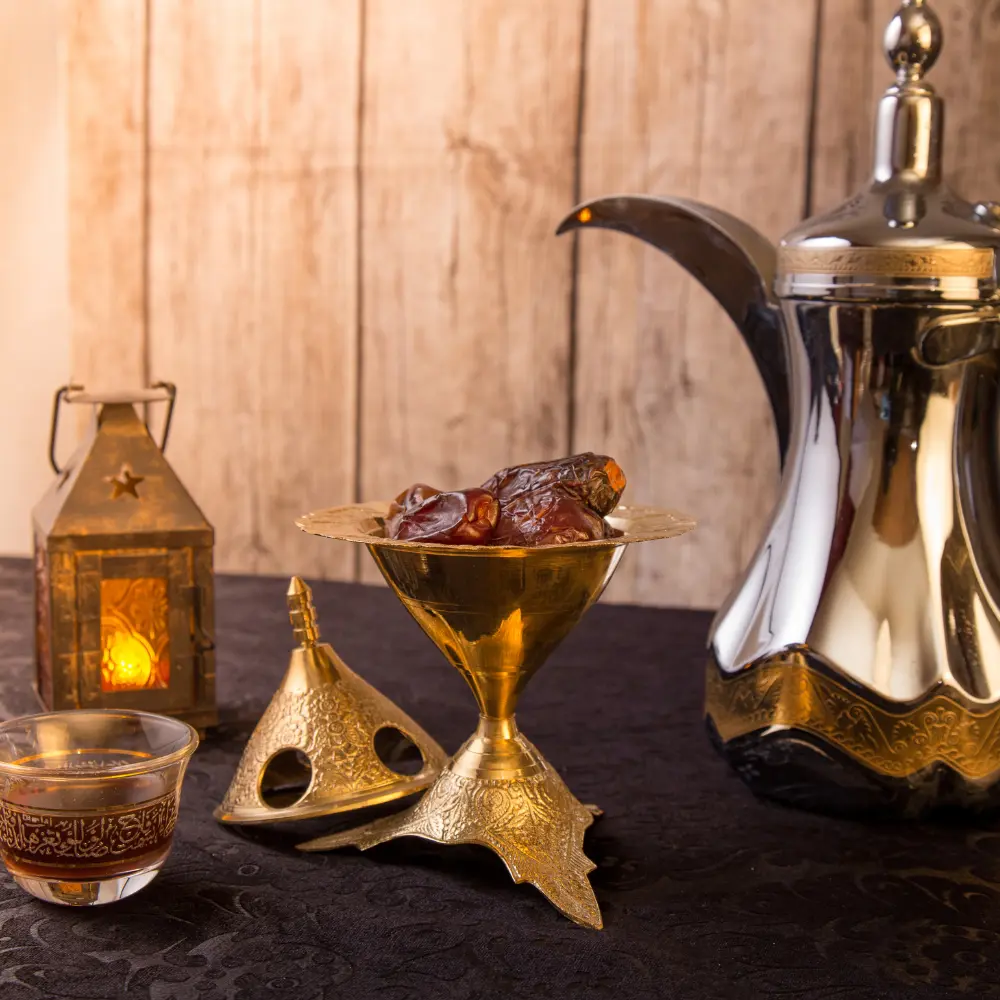
The Sufi monks in Yemen are often credited with being the first to roast coffee beans and brew them into a hot drink. They found that this beverage had a stimulating effect, aiding them to stay awake during their late-night devotions and long hours of prayer. By the 15th century, coffee had become an integral part of Yemeni society, and the country had started to cultivate coffee on a large scale. (1)
Arabic Coffee and Trade
As coffee’s popularity grew in Yemen, it quickly caught the attention of traders who saw its potential as a valuable commodity. Coffee beans were shipped to other parts of the Arabian Peninsula, sparking the beginning of a vibrant coffee trade. The port city of Mocha, in Yemen, became the bustling hub of this trade, and “Mocha coffee” became a well-known term. (2)

Arabs held a monopoly on coffee production for a long time, with coffee beans being a highly guarded secret. They exported roasted or boiled beans, which could not be used to grow new coffee plants, ensuring that coffee production remained exclusively within the Arabian Peninsula.
Influence of Arabic Coffee on Global Coffee Culture
This delectable coffee played a pivotal role in shaping global coffee culture. The first coffeehouses, known as ‘qahveh khaneh,’ originated in the Middle East. These establishments served as social gathering spots where people would drink coffee, engage in conversation, listen to music, and play chess. The concept of coffeehouses soon spread to Europe, deeply influencing social structures and habits.
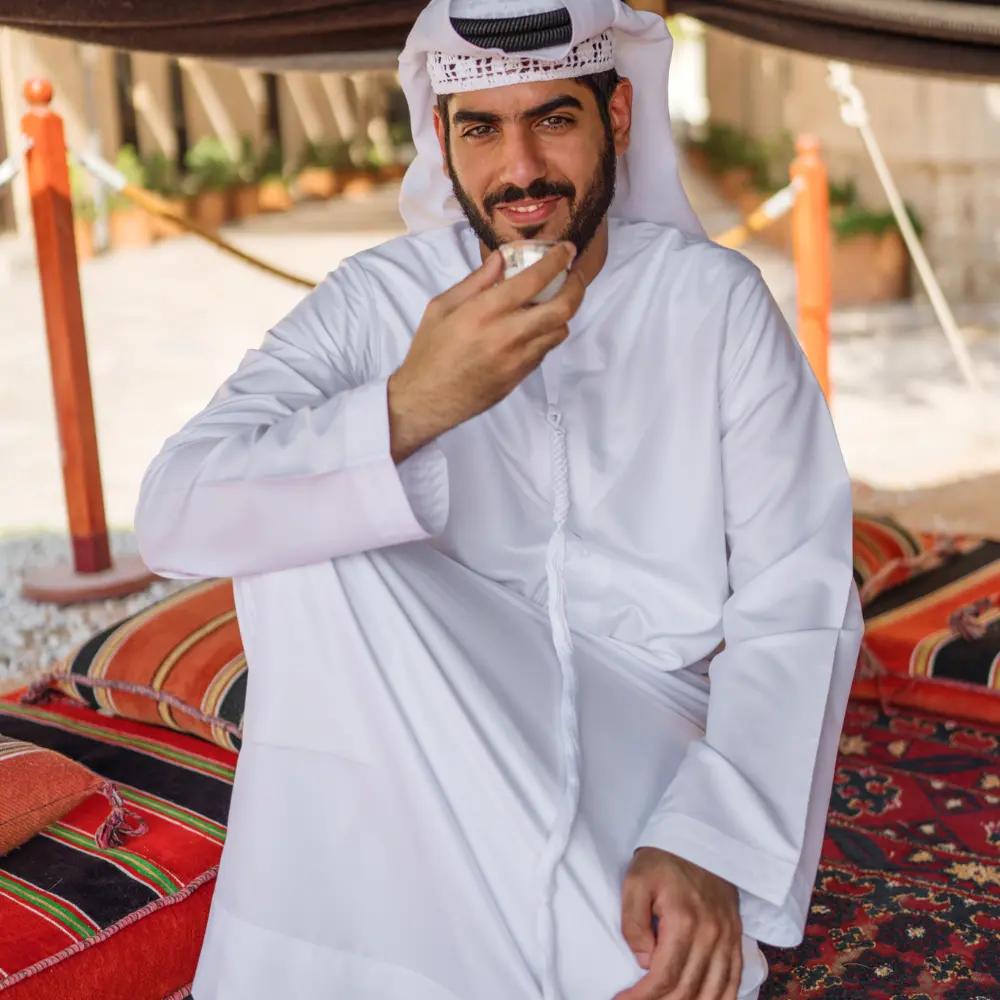
Moreover, the tradition of roasting coffee beans to develop flavor, a practice first begun by the Sufis in Yemen, is now a universal method of coffee preparation. The Arabic coffee pot, or ‘dallah,’ has also become a symbol of the art of coffee brewing.
Despite the evolution of coffee culture and the introduction of various brewing methods and coffee types worldwide, Arabic coffee has maintained its unique identity. Its rich, complex flavor profile, coupled with the distinctive ritual of its preparation and serving, continues to captivate coffee lovers across the globe.
The Geographical Spectrum of Arabic Coffee
While the term “Arabic coffee” might suggest a singular origin, in reality, it encompasses a variety of styles and traditions across numerous countries. The Arabian Peninsula, including Saudi Arabia, Yemen, and the United Arab Emirates, is the historical birthplace of this beverage. Here, the coffee, known as ‘Gahwa,’ is lightly roasted and often flavored with cardamom.
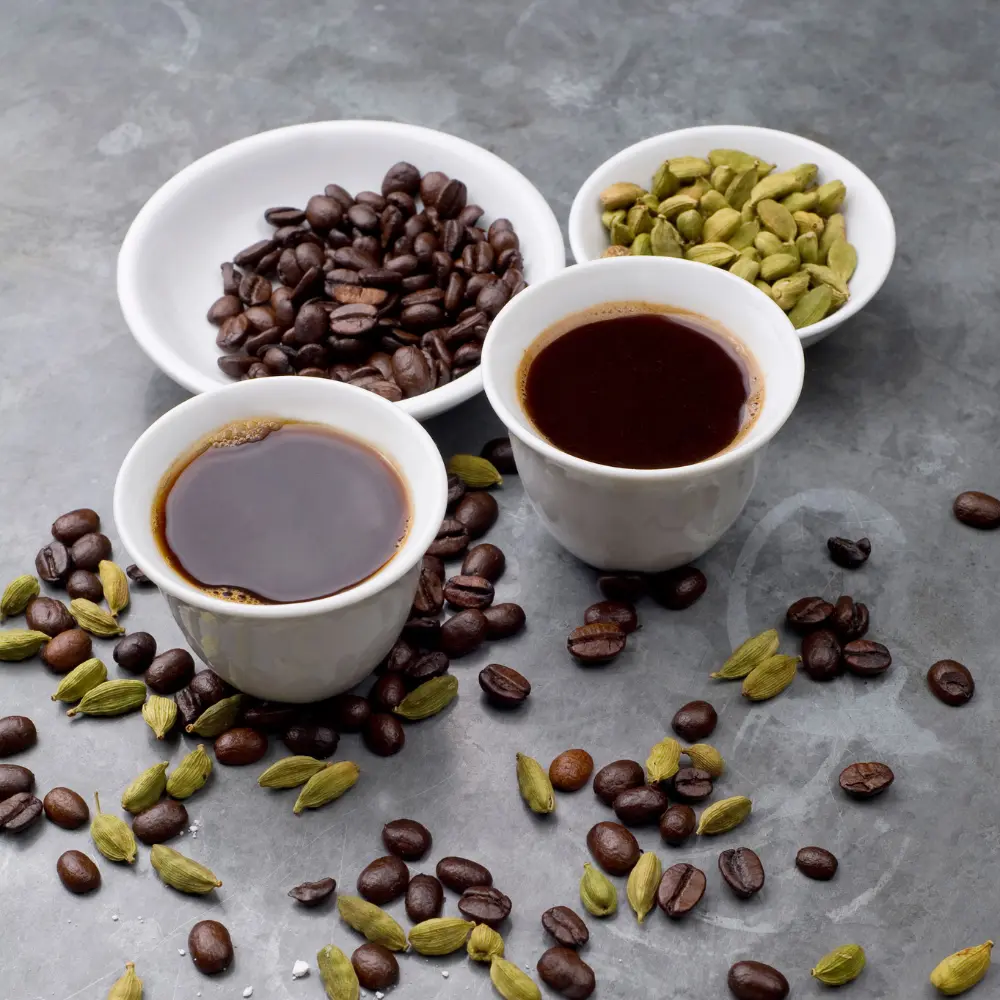
Beyond the Arabian Peninsula, Arabic coffee also has a strong presence in other Middle Eastern nations like Jordan, Syria, and Lebanon. Each region has its variations, with different roasts, spices, and brewing methods, reflecting the diversity within this coffee tradition.
In North Africa, countries like Morocco, Algeria, and Tunisia also have their unique interpretations of this coffee, often influenced by Ottoman and European coffee traditions.
Additionally, Gahwa coffee has found its way to the Horn of Africa, countries like Ethiopia and Somalia, where it’s enjoyed with local spices and variations in brewing techniques.
Thus, Arabic coffee is not limited to a single country or region but is a collective term for a wide variety of coffee traditions throughout the Arab world and beyond.
The Cultural Significance of Arabic Coffee
This delectable coffee, brewed in the traditional Arabic coffee pot or ‘dallah,’ is much more than a mere beverage in Arab societies. It’s a cultural symbol that encapsulates hospitality, friendship, tradition, and respect. Its significance transcends generations and is deeply woven into the fabric of Arab society. (3)
Arabic Coffee in Social Gatherings
In Arab society, the act of drinking coffee is fundamentally social. Gahwa coffee is a staple at all gatherings, whether they be among family, friends, or formal events. The coffee-serving ritual fosters a sense of community, providing an opportunity for people to connect, converse, and share stories.
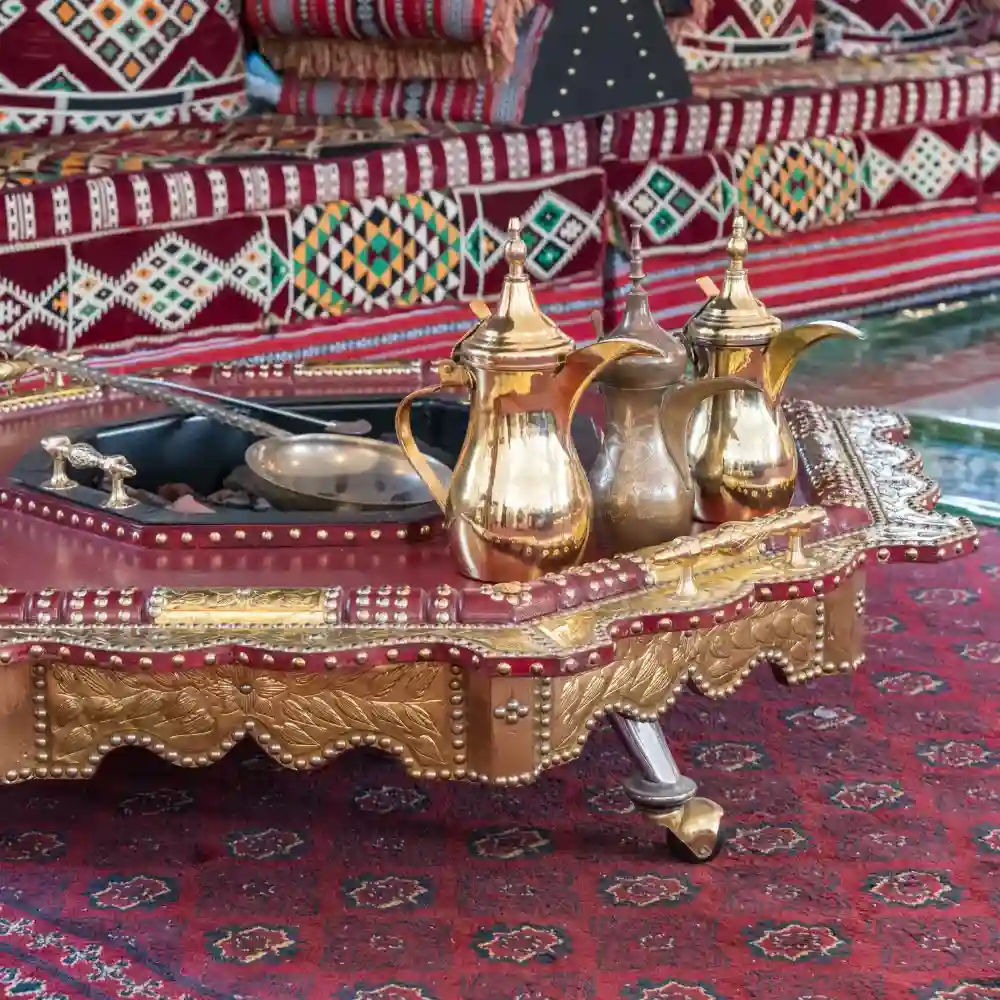
The brewing of Gahwa coffee itself is a social event. As mentioned before, the coffee is prepared in a dallah over a fire or stove, and the brewing process is often carried out in the presence of guests, serving both as a spectacle and a conversation starter.
Arabic Coffee as a Sign of Hospitality
The serving of this coffee is an important part of Arab hospitality. Guests are always offered Gahwa coffee, usually accompanied by dates or other sweet treats. It’s a gesture that showcases the host’s generosity and goodwill.
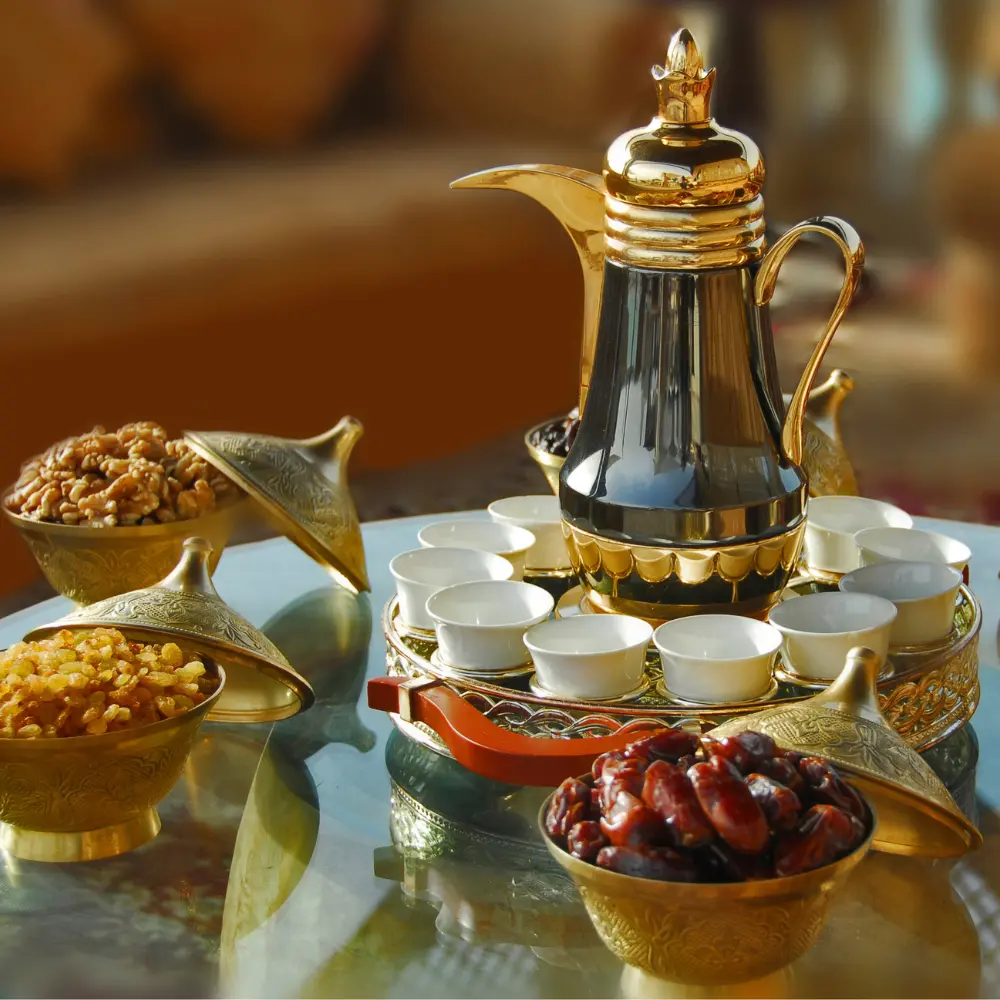
In many Arab homes, a dallah and small, handle-less cups, known as ‘finjan,’ are kept ready to serve coffee to unexpected guests. It’s not uncommon for the oldest or the most respected person in the gathering to pour the coffee, further signifying the respect and honor accorded to guests.
Symbolism and Rituals Associated with Arabic Coffee
Arabic coffee is steeped in symbolic rituals that convey respect and camaraderie. For example, coffee is traditionally served from the left hand and received with the right one, symbolizing respect between the host and the guest.
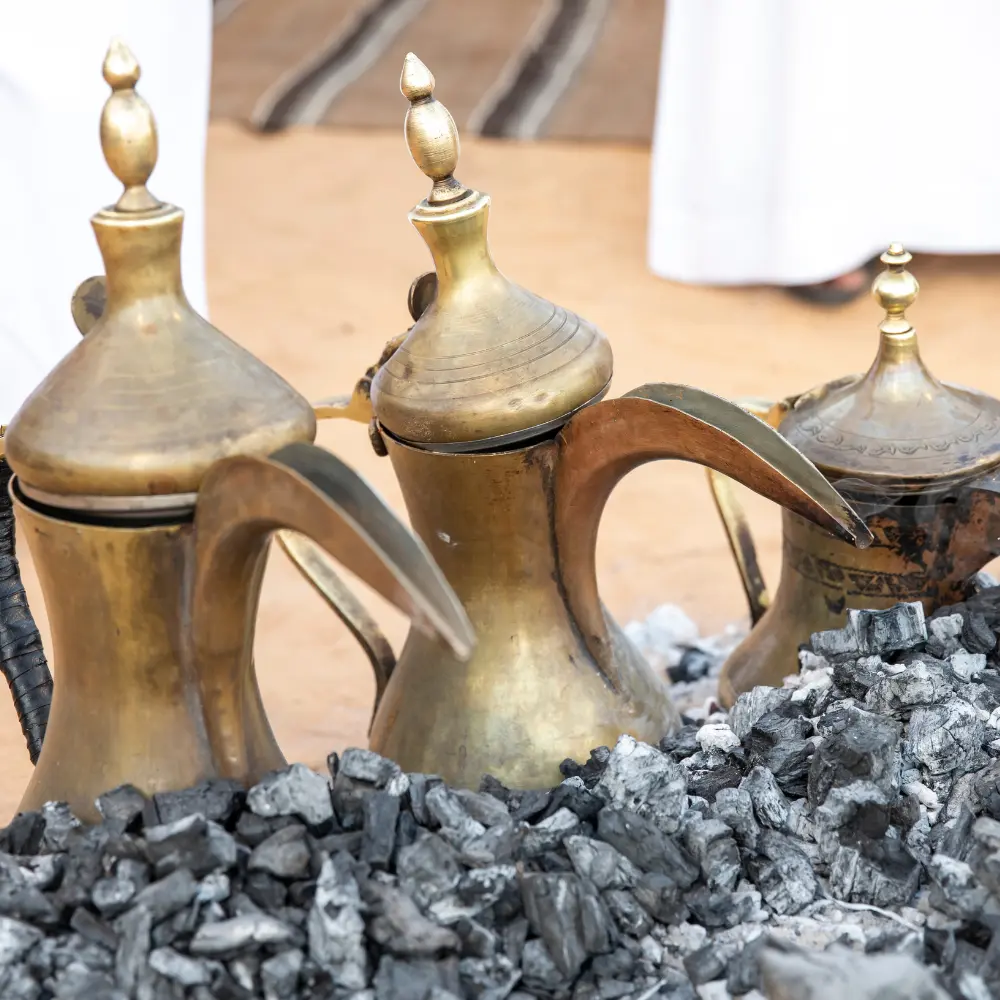
The act of pouring is also filled with symbolism. The pourer fills only a third or half of the cup, which indicates that the guest is welcome to stay for longer and enjoy more coffee. When a guest has had enough, they shake the cup from side to side to let the host know they are finished.
The dallah itself is a symbol of hospitality and tradition. Often ornately decorated, the Arabic coffee pot is as much a piece of art as it is a functional tool, embodying the rich cultural heritage of the Arab world.
The cultural significance of Gahwa coffee extends far beyond its taste. It’s a symbol of unity, a vehicle for hospitality, and a medium for preserving age-old traditions. Its deep-rooted cultural significance makes it a truly distinctive aspect of Arab heritage.
Understanding the Taste Profile of Arabic Coffee
The taste of this coffee beverage is a complex symphony of flavors that is as intriguing as the traditions it represents. From the carefully selected beans to the aromatic spices, each component plays a crucial role in creating its distinctive flavor profile. Understanding these elements allows us to appreciate the depth and uniqueness of this coffee.
Arabica Beans and Their Unique Characteristics
The base of any good cup of Arabic coffee is high-quality Arabica beans. Native to the highlands of Ethiopia, Arabica beans are considered superior to other coffee varieties due to their balanced flavor and lower acidity. They are characterized by their bright, fruity, and slightly wine-like flavor, which forms the perfect canvas for the spice-infused brew of Gahwa coffee.

Arabica beans are lightly roasted for Arabic coffee, unlike the dark roasts common in Western coffee varieties. This light roast allows the nuanced flavors of the beans to shine through, complementing rather than overshadowing the delicate notes of the spices.
The Role of Cardamom in Arabic Coffee
No discussion about the taste of this coffee drink can be complete without mentioning cardamom. This aromatic spice is a defining feature of this coffee, lending it a warm, slightly sweet flavor that sets it apart from other coffee types.
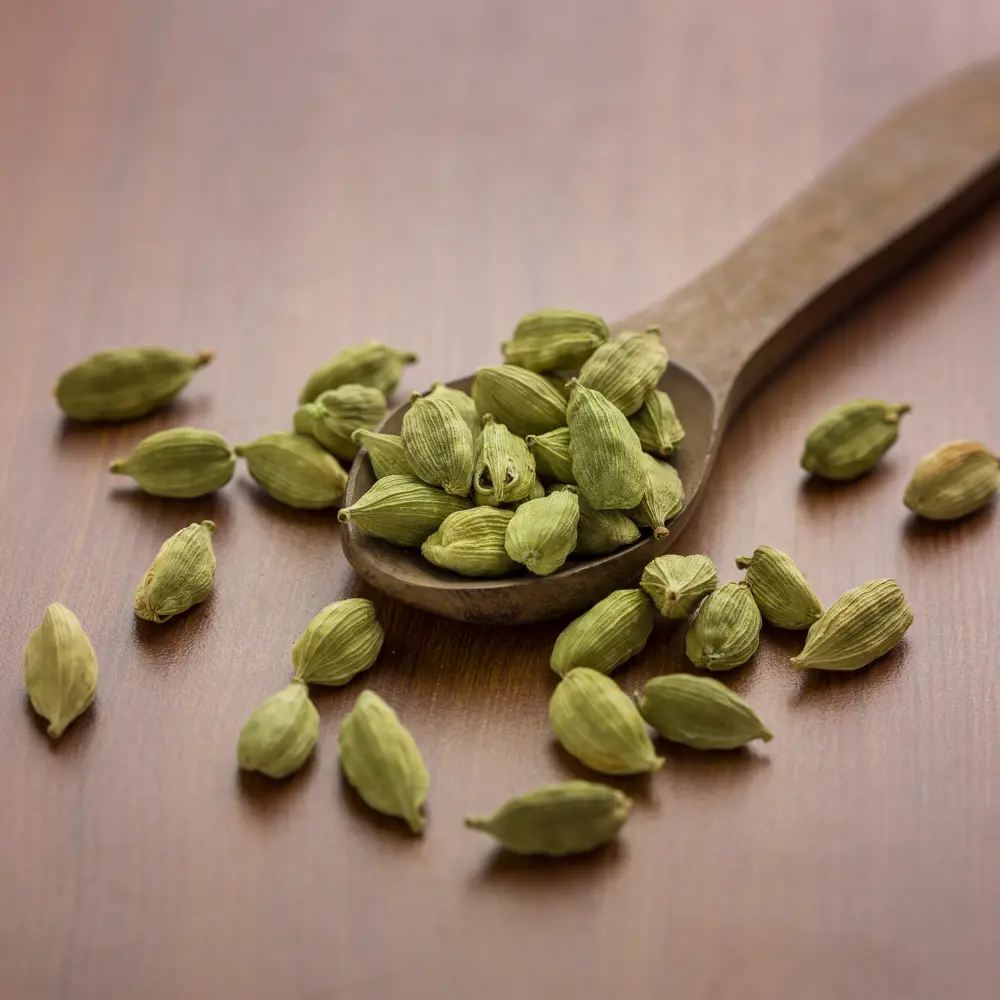
The green pods are often lightly crushed and added to the coffee during the brewing process, allowing their unique flavor to infuse the brew. The quantity of cardamom can be adjusted according to personal preference, ranging from a subtle hint to a dominant flavor.
The Balance of Flavors: Bitterness, Sweetness, and Spice
Achieving the perfect balance of flavors is a delicate art in Gahwa coffee preparation. The bitterness of the coffee beans, the sweetness of the cardamom, and the potential addition of other spices like saffron or cloves create a harmonious blend that is rich and multidimensional.
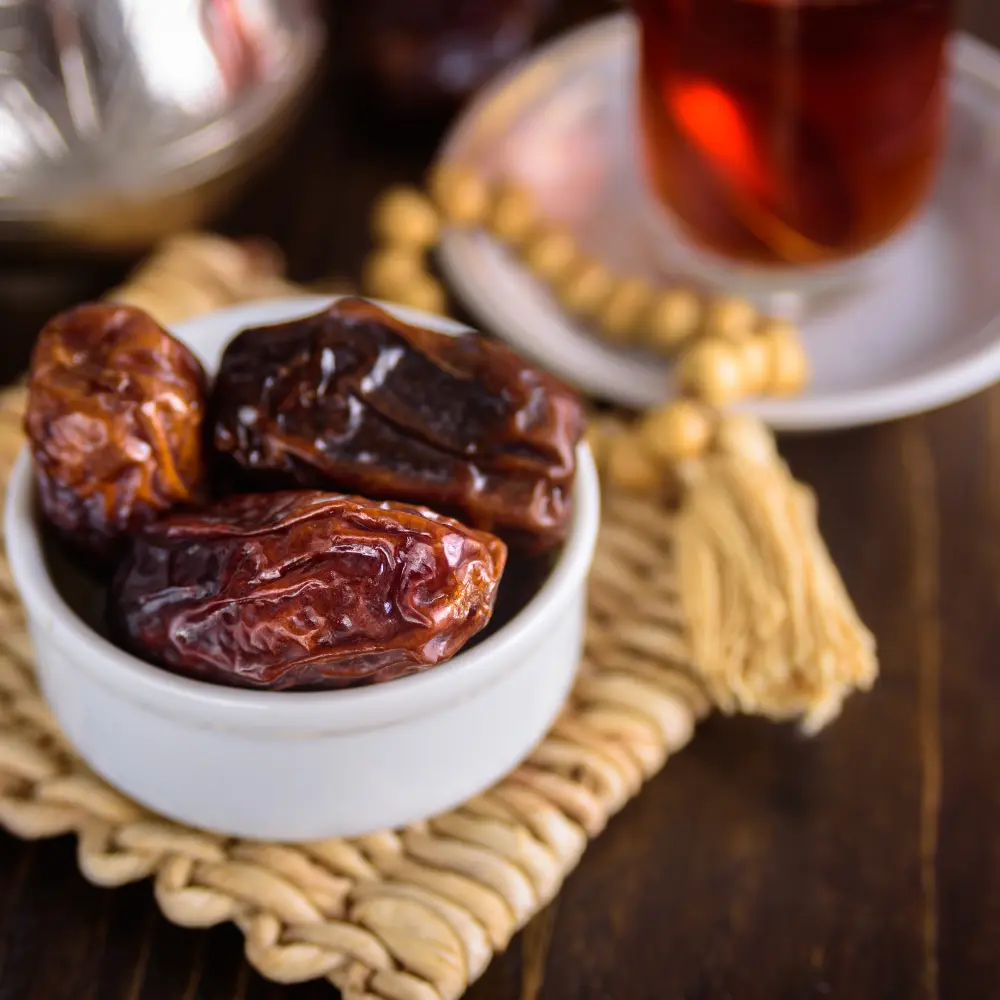
Gahwa coffee is traditionally served without sugar, allowing the natural flavors to be savored. However, it’s often paired with sweet dates, which create a delightful contrast and balance the bitterness of the coffee.
In the world of Arabic coffee, every sip tells a story. It’s a story of carefully selected beans, aromatic spices, and an artful balance of flavors. As you take a moment to appreciate the taste of this coffee, you are experiencing a piece of a rich, ancient tradition that continues to thrive today.
Brewing Arabic Coffee: A Detailed Guide
Brewing a perfect cup of Arabic coffee, or Gahwa, is an art that requires the right tools, the correct process, and a handful of secret tips that ensure an exceptional brew. This detailed guide will provide you with insights into each of these elements, bringing the rich and aromatic experience of traditional Arabic coffee to your home.
Choosing the Right Equipment
The equipment you use to brew your Gahwa plays a significant role in the taste and quality of your coffee. The most important piece of equipment is the traditional Dallah coffee pot. This iconic pot, often made of brass or steel, has a distinctive shape with a long spout and a curved handle, specifically designed to control the pour and preserve the heat of the coffee.
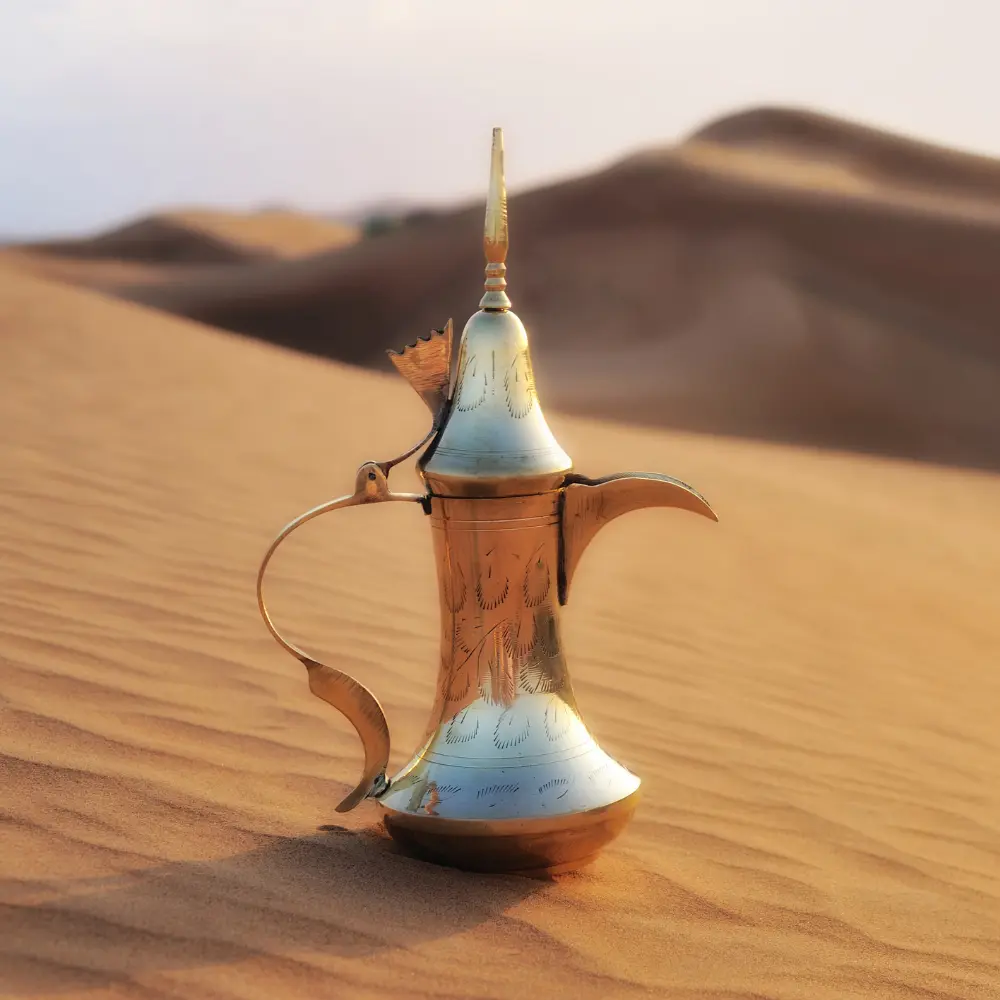
In addition to the Dallah, you’ll also need a coffee grinder to grind your Arabica beans. A fine grind is ideal for Gahwa as it allows the maximum flavor to be extracted. Finally, small, handleless cups known as Finjan are used to serve the coffee, offering the perfect amount for savoring the flavors without the coffee becoming cold.
This Brass Coffee Arabic Pot made of brass. Have Beautiful engraved design on the outer surface with glossy finish.
About Item:- Size of the item is 8 Inches Height, 6 Inches Width. Weight 375 Gram Approx.
This Arabic Pot made of Pure Brass Metal, Having engraved design with glossy finished.
As Gift Like, marriage party, family friend and neighbor, Christmas, Easter, New Year and thank Giving Gift, Diwali, Eid, Holi, Birthday.
NOTE: Because it is handmade product so, Size can be vary by 1-2 cm. Color of the item can be slightly different from the image.
The Brewing Process Explained
Once you’ve got your equipment ready, it’s time to delve into the brewing process. The first step is to lightly roast your Arabica beans until they are golden brown. Once roasted, they should be ground to a fine consistency.

Next, fill your Dallah with water and bring it to a boil. Once the water is boiling, reduce the heat and add your ground coffee. Let it simmer for about 10-15 minutes. Following this, add your cardamom (and any other spices you desire, like saffron or cloves). Let it simmer for another 10 minutes.
After simmering, remove the pot from the heat and let it sit for a few minutes. This allows the coffee grounds to settle at the bottom of the pot. Your coffee is now ready to be served. Remember to pour it gently into the Finjan, avoiding the disturbance of the settled grounds.
Tips for Achieving the Perfect Brew

Brewing the perfect Gahwa is about more than just following the process; it’s about finesse and attention to detail. Here are some tips to achieve that perfect brew:
- Always use fresh, high-quality Arabica beans for the best flavor.
- Don’t rush the brewing process. Allow the coffee to simmer gently to extract maximum flavor.
- Adjust the amount of cardamom and other spices according to your taste preference. Remember, the beauty of this coffee is in its balance of flavors.
- Serve the coffee immediately after brewing to enjoy its aroma and taste at its peak.
With the right tools, a clear understanding of the brewing process, and a few expert tips, you can enjoy the rich, complex flavors of Gahwa coffee in the comfort of your own home. Remember, the art of brewing Gahwa is a journey – take the time to savor the process as much as the result.
Duel of the Brews: Arabic Coffee vs Turkish Coffee
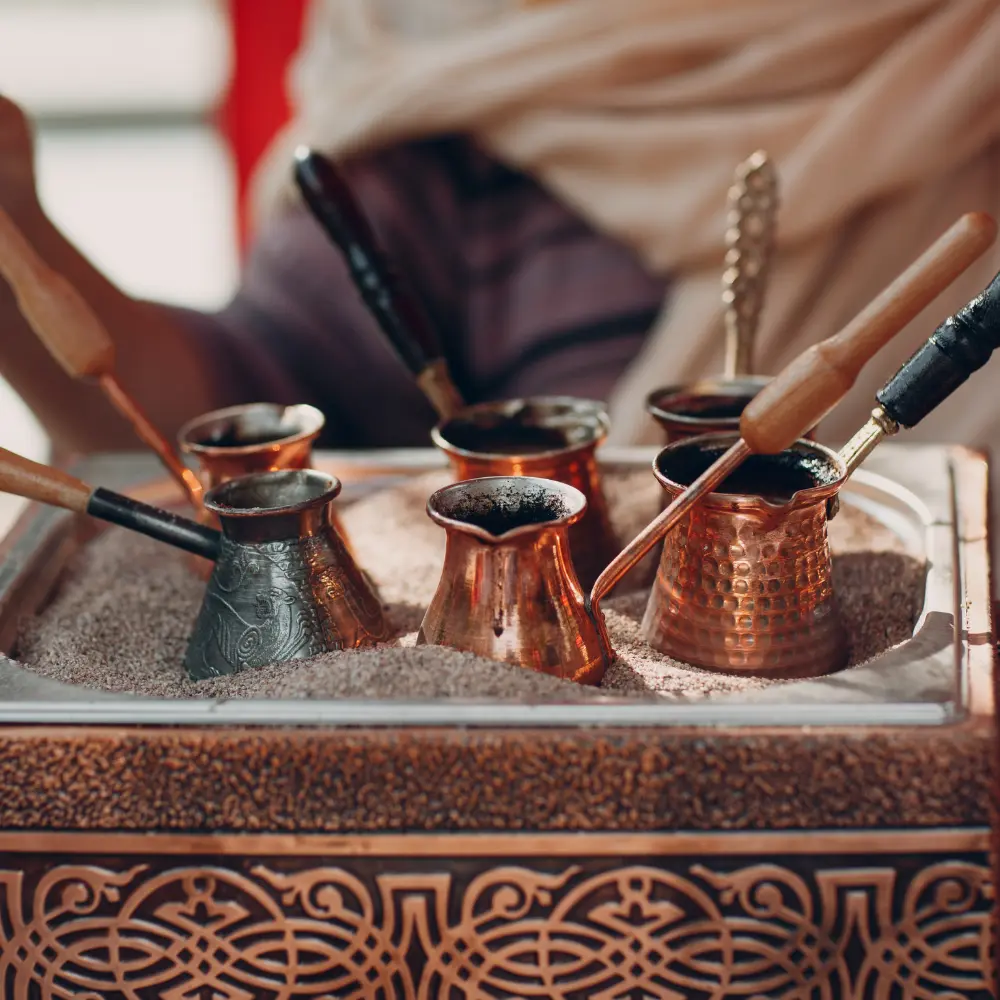
When it comes to traditional coffee cultures, Arabic and Turkish stand out as two of the most influential. Despite being geographically close and sharing a love for finely ground coffee and elaborate brewing methods, Arabic and Turkish coffee have distinct characteristics that set them apart. Here, we explore these differences in our ‘Duel of the Brews.’
Coffee Beans and Roast
When it comes to the beans and roast, Arabic and Turkish coffee take different paths. Arabic coffee uses lightly roasted Arabica beans, which impart a smooth, mild flavor. On the contrary, Turkish coffee generally uses a darker roast, creating a more robust and intense flavor profile.
Preparation Methods
The brewing methods for these two coffees are also quite distinct. Arabic coffee is traditionally made in a Dallah and is often flavored with cardamom, giving it a unique, spiced aroma. After boiling, the coffee is left to sit, allowing the grounds to settle at the bottom of the pot before serving.
In contrast, Turkish coffee is brewed in a ‘cezve,’ a small pot with a long handle. It’s usually sweetened and occasionally spiced. Unlike Arabic coffee, Turkish coffee is served with the grounds, creating a thick layer of sludge at the bottom of the cup.
Serving Styles
Arabic and Turkish coffees also differ in their serving styles. Arabic coffee is served in small, handleless cups called ‘finjan,’ usually alongside dates or other sweet treats. Turkish coffee, meanwhile, is served in small, ornate cups called ‘kahve fincanı’ and is often accompanied by a glass of water and a piece of Turkish delight.
A Shared Love for Tradition
Despite these differences, both Arabic and Turkish coffee share a common thread – they are not just beverages, but an integral part of the cultures they represent. They are steeped in tradition, ritual, and a deep respect for the art of coffee making. Whether you prefer the spiced, subtly nuanced flavors of Gahwa coffee or the strong, sweet taste of Turkish coffee, both offer a unique and enriching coffee experience.
Serving Arabic Coffee: Etiquette and Customs
Serving Arabic coffee, or Gahwa is an elaborate ritual steeped in tradition and cultural significance. As discussed earlier, it’s not just about providing a beverage; it’s a demonstration of hospitality, respect, and camaraderie. Understanding the etiquette and customs around serving this coffee provides insight into the rich cultural tapestry of the Arab world.
Serving Order and Quantity
The order and quantity in which this coffee is served carry significant cultural meaning. It’s customary to serve the coffee starting with the guest of honor or the eldest person present, moving clockwise around the gathering. This practice is a sign of respect and acknowledges the guest’s importance.

When it comes to quantity, the finjan is only filled up to one-third or half. This isn’t due to stinginess but rather the opposite. As mentioned before, it’s an invitation for the guest to stay and enjoy more rounds of coffee, symbolizing prolonged hospitality and friendship.
Rituals and Customs Around Serving Arabic Coffee
Serving this delectable coffee drink is steeped in rituals that extend beyond the act of pouring coffee. The coffee is traditionally served by the youngest person in the gathering, who moves around the room carrying the Dallah and finjans on a tray.
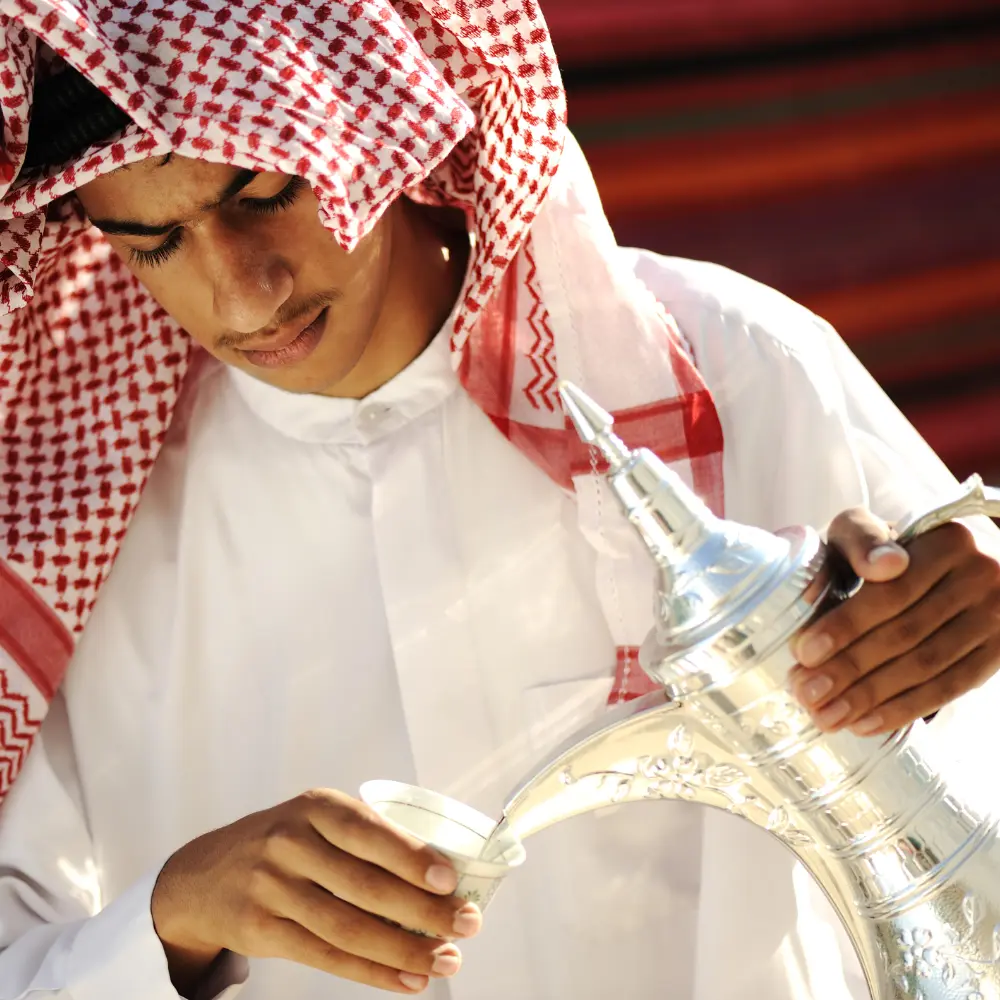
The server pours the coffee with their left hand while holding the finjan in their right, a practice that stems from Bedouin traditions. The coffee is always served and received with the right hand, a sign of respect between the host and the guest.
The art of serving Gahwa coffee is a beautiful dance of traditions, etiquette, and customs. It’s a testament to the Arab world’s hospitality, where a simple beverage like Gahwa is transformed into a meaningful and rich cultural experience.
Conclusion: A Journey Through the World of Arabic Coffee
Arabic coffee, with its distinct flavor profile and elaborate preparation and serving rituals, offers a fascinating glimpse into the rich tapestry of Arab culture. As we’ve journeyed through the history, cultural significance, taste profile, brewing techniques, and serving etiquette of Gahwa, it’s clear that this is not just a beverage—it’s a tradition, a gesture of hospitality, and an integral part of social life in the Arab world.
Brewed in a Dallah, the iconic Arabic coffee pot, and served in small cups known as finjans, every sip of Gahwa tells a story—a story of centuries-old traditions, warm gatherings, and shared moments. Whether you’re a coffee connoisseur or a curious beginner, understanding the world of this delectable coffee can deepen your appreciation for this rich, spiced brew.
In the end, this coffee is more than the sum of its parts. It’s a testament to the art of taking simple ingredients and transforming them into something that holds immense cultural significance. As you savor your next cup of Gahwa coffee, remember the history, the artistry, and the traditions that have gone into its making. And perhaps, you’ll find that it’s not just coffee—it’s an experience.
FAQ
How is Arabic coffee different from other types of coffee?
This coffee is unique in its flavor profile and preparation method. It's typically made from lightly roasted Arabica beans and is often flavored with cardamom. It's brewed in a traditional Dallah pot, and the coffee is usually served unfiltered, allowing for a distinct, rich taste.
What are the key elements to consider when brewing Arabic coffee?
When brewing this coffee, the selection of coffee beans, roast level, and the addition of spices, particularly cardamom, are important. Also crucial is the use of a Dallah coffee pot and following the traditional brewing process, which includes boiling and then allowing the coffee to sit and the grounds to settle.
What rituals are associated with the serving of Gahwa coffee?
The serving of this coffee involves a specific order, starting with the guest of honor or eldest person, and only filling the cups (finjans) up to one-third or half. The youngest person typically serves the coffee, and when a guest has had enough, they shake their cup from side to side to signal the server.
What role does Arabic coffee play in social gatherings and events?
This coffee plays a significant role in social gatherings and events in the Arab world. Serving Gahwa coffee is a sign of hospitality and a way of welcoming guests. The rituals and customs associated with its serving often foster a sense of camaraderie and respect among the attendees.









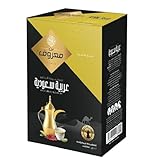











2 comments
Thank you for your interesting article. Very useful.
In Rituals and Customs section I think you mean the finjan is held in the right, not the dallah.
Hi Richard,
Thank you for your kind words about the article and for pointing out the mix-up regarding the finjan and the dallah. You’re absolutely right; it is indeed the finjan that should be held in the right hand. I appreciate your attention to detail and helping us maintain accuracy in our content. We’ll make the necessary correction.
Thanks again for your valuable feedback!